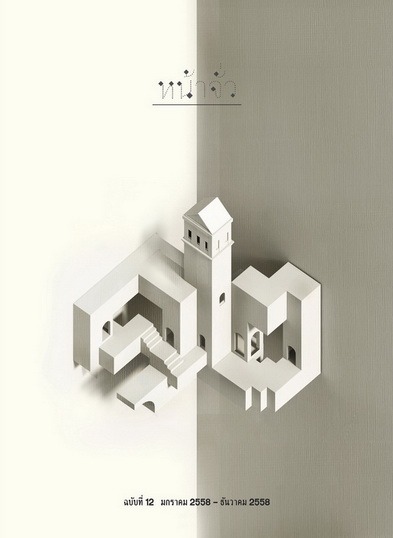วัดธรรมยุติกนิกายในจังหวัดอุบลราชธานี/ Buddhist Monasteries of Dhammayuttika Nikaya in Ubon Ratchathani
Main Article Content
Abstract
บทคัดย่อ
บทความนี้เป็นส่วนหนึ่งของวิทยานิพนธ์ระดับปริญญามหาบัณฑิต มหาวิทยาลัย ศิลปากร ในหัวข้อ “การศึกษาวัดธรรมยุติกนิกายในจังหวัดอุบลราชธานี” โดยมีจุดมุ่งหมายที่จะศึกษาถึงรูปแบบ รวมไปถึงแนวความคิด อิทธิพล หรือปัจจัยที่ส่งผลให้เกิดงานสถาปัตยกรรมธรรมยุติกนิกายในจังหวัดอุบลราชธานี ยิ่งไปกว่านั้นยังได้ศึกษาถึงบทบาทของวัดธรรมยุติกนิกายในจังหวัดอุบลราชธานีที่มีต่อสังคม จากการศึกษาพบว่า สิม (อุโบสถ) เป็นสถาปัตยกรรมสำคัญที่สุดภายในวัดธรรมยุติกนิกาย จังหวัดอุบลราชธานี แม้ไม่มีลักษณะเฉพาะของตำแหน่งที่ตั้งในผังวัด แต่สิมมักตั้งอยู่ในตำแหน่งกึ่งกลางวัด ลักษณะสถาปัตย- กรรมและการประดับตกแต่งสิมวัดธรรมยุติกนิกาย จังหวัดอุบลราชธานีสะท้อนความเป็นวัดธรรมยุติกนิกาย ด้วยการประดับหน้าบันด้วยรูปเจดีย์ทรงระฆัง โดยสิมวัดสุปัฏนารามวรวิหารเป็นวัดแรกที่แสดงสัญลักษณ์เจดีย์ทรงระฆังที่หน้าบันของสิม นอกจากนั้นลักษณะหน้าบันแบบไม่มีไขราหน้าจั่ว มีเครื่อง ประดับหลังคาด้วยเครื่องลำยองนาคก็เป็นลักษณะที่สิมวัดสุปัฏนารามวรวิหารเป็นต้นแบบให้กับสิม (อุโบสถ) วัดธรรมยุติกนิกายอื่นๆ
วัดธรรมยุติกนิกายในจังหวัดอุบลราชธานีแบ่งออกได้เป็น 3 ยุคคือ ยุคที่ 1 แห่งการก่อตั้งวัดธรรมยุติกนิกาย พ.ศ. 2394–2452 สมัยรัชกาลที่ 4–5, ยุคที่ 2 ช่วง พ.ศ. 2453–2480 สมัยรัชกาลที่ 6 จนกระทั่งการเปลี่ยน แปลงการปกครองและรัชกาลที่ 8 และยุคที่ 3 พ.ศ. 2481–ปัจจุบัน ตั้งแต่สมัยจอมพล ป. พิบูลสงครามเป็นต้นมา โดยสิมวัดธรรมยุติกนิกายยุคที่ 1 ยังไม่มีลักษณะเฉพาะ มีลักษณะอย่างพื้นถิ่นในท้องที่ สิมยุคที่ 2 เริ่มมีเอกลักษณ์โดยใช้รูปแบบวัดธรรมยุติกนิกายจากกรุงเทพฯ ผสมตะวันตก พื้นถิ่น และงานช่างจีนและญวน และสิมวัดธรรมยุติกนิกายยุคที่ 3 ใช้รูปแบบส่วนกลางและคงองค์ประกอบสิมวัดสุปัฏนารามวรวิหาร
Abstract
This article is part of a master’s degree thesis entitled “Buddhist Monasteries of Dhammayuttika Nikaya in Ubon Ratchathani” at Silpakorn University, Thailand. The article aims to study characteristics of Buddhist monasteries of Dhammayuttika Nikaya in Ubon Ratchathani Province. It also attempts to seek for its concepts as well as influence and factors which effected architecture and role of Dhammayuttika monasteries to the society in Ubon Ratchathani. According to the study, sim (ordination hall) has been the most important in a Dhammayuttika monastic compound in Ubon Ratchathani. Even though there is no specific location of an ubosatha in a monastic layout, an ubosatha has been often situated at the center of a compound. Sim of Dhammayuttika in Ubon Ratchathani was often adorned with relief of a bell-shaped pagoda at a pediment which was considered as a symbol of Dhammayuttika. Sim at Wat Supattanaram Worawihan was the first to adorn pediments with this symbol. Furthermore, its pediments were without a gable overhang which the apex and two lower ends of the gable roof were adorned with heads of naga. These ornaments became prototypes for decoration of other Dhammayuttika sims in Ubon Ratchathani.
Buddhist monasteries of Dhammayuttika Nikaya in Ubon Ratchathan can be classified in three periods: first period of establishing Dhammayuttika monasteries (B.E. 2394-2452) during the reigns of King Rama IV – V; second period (B.E. 2453-2480) from the reign of King Rama VI to the Siamese Revolution in 1932; and third period (B.E. 2481-present) from Plaek Phibunsongkhram rule to present.
Sims of the first period had no specific characteristics but had characteristics same as local; those of the second period had its own styles and characteristics with had Dhammayuttika Nikaya in Bangkok as a model, combining with western, local, Chinese and Vietnamese style; and those of the third period had characteristics parallel to that of central Thailand but some architectural elements were after those at Wat Supattanaram Worawihan.


